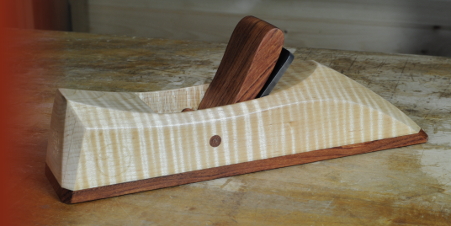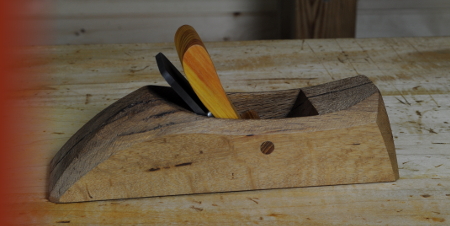How to use your new Scott Meek Woodworks wood bodied plane
The video below was filmed for Highland Woodworking at their store in Atlanta. I’ve wanted to do a video on adjusting wooden planes and this turned out so well, I had to add it here for my customers.
The following is taken from the instructions that I send with each plane. If you would like this in a printable format, you can find the Wood Plane Instructions here and the Wood Plane Troubleshooting here.
If you have never used a wood bodied plane before, there are a couple things that will be helpful to know.
- First, it’s wood. I know, that’s obvious, but, as with all wood, it can move with drastic changes in humidity. You should let your plane acclimate to your shop for a week before truing the sole. I make sure they are flat before they leave my shop, but due to that humidity factor, it may have moved slightly by the time it gets to you. Using a straight edge, verify the flatness of the sole. I like to hold it up to a light to do this. That way the light shines through between the straight edge and the sole and you can see clearly what it’s doing. If it’s not flat, you can either use another plane that you know is flat and true the sole, or you can use spray adhesive and attach sand paper to a flat surface, then rub the plane in a forward motion (as if you were planing with it) on the sand paper until the sole is flat. Be sure to retreat the blade into the body of the plane so that you don’t mess up that sharp cutting edge! (How to do this is below.) The blade must be wedged into the plane when you flatten the sole because that wedge puts the plane under pressure. If you flattened without it under pressure, once you wedged the blade in place, the sole would no longer be flat. Note: If you live in a climate with distinct seasonal changes, be sure to check your sole often to verify it’s flatness. After flattening, you can reseal the bottom with Shellac, oil, or even paste wax. Or not. It’s up to you.
- Your blade is sharp out of the box. However, under use, it won’t stay that way. If you are new to sharpening plane blades, I HIGHLY recommend Ron Hock’s book, The Perfect Edge. It’s the best resource out there for learning to sharpen any tool you have.
- To use your plane, you will want a small headed hammer to adjust the blade. I sell one on my website with a resin infused Maple head and Ash handle. I enjoy using it with my planes. You can also make one with a piece of round brass stock and a springy wood like Oak or Ash. I like brass because it won’t mushroom your plane blade. You could also use a ball peen hammer. As long as the head is small enough to tap the plane blade and the wedge, it will work.To adjust the blade forward (increase depth of cut), tap the back of the blade. Adjust it side to side by tapping one side of the blade or the other. To adjust the blade back into the plane body (decrease depth of cut), tap the back of the plane. This will take some practice, but with time and use, you will get the hang of how much tapping pressure to use. Remember, the thicker the cut, the more resistance the cut will give.
- With a brand new plane, the mouth will be very small, so don’t try to take too heavy of a shaving, or it will clog the mouth and you will have to loosen the blade and start adjusting it all over again. Again, with practice, this will become second nature. This brings us to our next point:
- The mouth. Depending on the plane you bought, the ideal mouth opening size will change. If you bought a smoother, you want as tightly closed mouth as possible. A smoother is for taking wispy thin final shavings. It’s the last plane you will use on a board. The smaller the mouth and the sharper the blade, the easier making those very thin shavings will be. If you bought a jack plane, the mouth size can very. If you already own a smoother you love using, then you may want your jack to take a heavier, intermediate shaving. If you aren’t able to take a shaving as thick as you want, use a mill file and open the mouth up a bit. Be careful not to go too far when doing this. A jointer will usually require a mouth that is more open to allow for heavy shavings. Over time, the mouth will open up. Every time you re-flatten the sole, it will remove a little of the mouth. If you get to a point in a few years (should be years before the mouth will get this big) where you don’t like how open the mouth is, you can send it back to me to have me insert a new mouth piece into the plane in front of the blade for a small fee, or ask me for instructions on how to do it yourself. Again, if you are using the plane correctly, it should be many years before you will need to do this.
- When tapping in the wedge, don’t hit it too hard or too many times. This could put undue pressure on the cross pin and potentially cause it to break. If you listen as you hit the back of the wedge, you will here a tonal change as it seats into place. After a couple taps, it should sound like you are hitting a solid block of wood, instead of two separate blocks rattling together. 1-3 light to decent taps should do it. To get an idea of the proper hardness to hit a wedge, it is approximately the same amount of force you would use when tapping a dovetail joint together. Firm hits, but not enough to dent the wood. When the wedge is seated properly, you shouldn’t be able to move it side to side without some pressure behind it. Again, this will come with practice.

